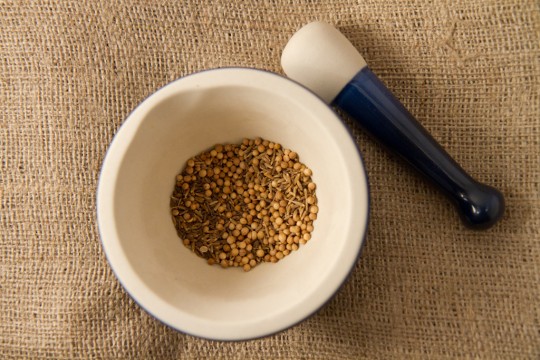
Harissa is a traditional North African chili paste. One of the many delights my Tunisian friend Salah introduced me to. It was in Santa Fe New Mexico, the land of chili peppers, that I learned about this spicy condiment that is so much more than your average hot sauce. For a while I bought it, sampling various brands, but I never really found any that I liked as much as the homemade stuff Salah would serve me, and it turns out it’s incredibly easy to make at home.

Traditionally harissa is added to tagines or couscous. You can use it as a condiment, incorporate it into marinades, or just straight up rub it on grilled or roasted meats. You can add a spoonful to the base of any soup, stew or braise, for an underlying layer of spice and heat. I often enjoy it with my morning eggs, or simply spread on toast.

The type of chili peppers you use will greatly affect the heat of the harissa. Try a combination of peppers for varying spice and flavor. I like to use abut 3/4 hot peppers, either piquin or de arbol, combined with 1/4 guajillo peppers to mellow out the otherwise fiery paste. If you prefer less heat, a combination of ancho and guajillo peppers will give you a mildly smokey spice. I use the chilies seeds and all, but slitting them open to remove the seeds (either wear gloves or wash your hands thoroughly afterwards!) will also reduce the amount of heat.
Of the most commonly found and used dried peppers, here’s the heat based on the Scoville scale:
40,000 – 58,000 – Piquin
15,000 – 30,000 – Chili de Arbol
2,500 – 5,000 – Guajilla
1,000 – 2,000 – Pasilla

Have fun and be careful. This is one spicy chili paste!
Harissa
Makes about 2.5 cups
4 oz. dried red chilies, stems removed, coarsely chopped
1 tablespoon dried mint
1 tablespoon freshly ground coriander
1 tablespoon freshly ground cumin
1 tablespoon freshly ground caraway seeds
1 tablespoon kosher salt
10 garlic cloves, peeled
Juice of 1 lemon
1/2 cup olive oil
Cover the chilies with boiling water and soak for 1 hour. Drain and add to the food processor with mint, spices, salt and garlic and puree until well blended, stopping to scrape the mixture down the sides as needed. Add the lemon juice, and with the food processor running, add the olive oil in a steady stream.
Spoon the harissa into a clean, glass jar. Cover the surface with olive oil and store in the refrigerator. If stored like this it should keep for several months. I find the flavor improves with time as the heat mellows and the spices permeate the mixture.



Jason Sandeman says:
Nice! I’ve used harrisa in the past in dishes at a restaurant I worked in – and was always in the juice if we ran out. I could totally see using this instead. The stuff our of the tube was really red though, and I see yours is pretty orange. Is it because there is a dye added to the commercial application?
Heather says:
The orange color came from the dried chilies I used – when I add more of the darker guajilla, or even anchos, it gets much darker. Some people also add tomato to it – there is tomato puree in the common tube stuff which probably accounts for the super red color. One of the prepared harissas I liked had sundried tomatoes which was a nice addition.
Daughter Fish says:
This looks delicious! It would make a lovely Christmas gift (wink, wink:)).
Heather says:
Oh, yes! Good thinking. Thomason Christmas goody boxes need to be resurrected this year!